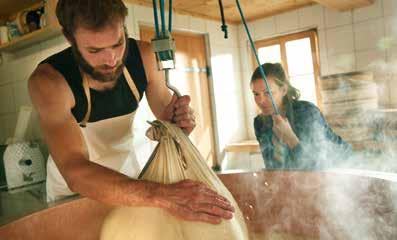
3 minute read
Architecture
Modernism and tradition
If a ranking of the most significant architectural regions in the world were to be drawn up today, Vorarlberg would, without a doubt, be in the top ten. However, this doesn’t just mean the significance of the individual constructions, but also their number and density.
This phenomenon is comparatively new. Whilst it is true that Vorarlberg’s baroque master builders are a fixed feature in specialist literature, whenever the Vorarlberg school of architecture or architects are mentioned, they mean the generation born since 1950 which has been influencing the architecture here for about the past 30 years. Without counting the handful of pioneers that preceded them, this amounts to over 60 people: considering the 400,000 inhabitants, this is an amazing number. Such a ratio is only possible in a region where architecture is appreciated, where one in four houses is designed by architects.
From construction artists to architects However, this is the result, rather than the explanation, of a development. “Construction artists” is what the players called themselves at the start since, in the face of a vehement conflict with the “establishment” of the building industry and chamber, the title “architect” was refused. According to one of the pioneers, public appearances, the joining of forces and dialogue were important right from the start. The ideal founded in terms of social policy – social, affordable, sustainable, regional – promoted the solidarity of a generation that was searching for new life forms and other ways of cultural expression, that was resisting the sell-out of their land, and that found expression in building. The new type of architecture started off in residential buildings – by way of examining already existing buildings or as a new structure, often for residential groups – and grew into a clear sign of the cultural restoration which soon extended to the economic elite and the public sector. However, as important as this environment was, there are always people who take responsibility, and Eberle, Gnaiger, Dietrich, Kaufmann and Ritsch have long since become international stars with chairs at renowned universities.

Islen holiday home in Mellau
Landscape and wooden buildings Located somewhat off the beaten track, the Bregenzerwald was part of this development, although in a way of its own. In contrast to the densely populated, industrial and commercial Rhine Valley with its mainly suburban structure, landscape, nature and rural craftsmanship culture is of great importance in the Bregenzerwald. Outside of the Bregenzerwald, groups of houses and farms dominate, whereas inside the Bregenzerwald it is the single-ridge house, outside of the Bregenzerwald it is households which commission the building, whereas inside the Bregenzerwald it is the young craftsmen. The Bregenzerwälder have a greater affinity for craftsmanship in general (Werkraum→ page 82): for example, it is in the carpentry trade that the Kaufmann family of architects has its roots. While, following the initial years, the formal experiment is in demand outside, the tendency towards stringency and sobriety increases inside. Rural pragmatism and the discipline of construction with timber, which is now state-of-the-art, appears to be more effective here. Recently, examining the old buildings is also gaining in importance. Above all, however, the new buildings fit in with the surrounding landscape with regard to material, size and proportion. Is it this attitude that shies at the eccentric and that searches for the typical rather than the unique which guarantees this way of building a wide basis? In any case, good carpentry firms now build residential buildings which architects in other places wouldn’t be capable of building: it is these houses which graze casually in the field like the cattle which are as typical of the region as the farmhouses and the churches.
Worth a visit It is hard to list remarkable buildings, since many of them are private residential buildings which are not accessible. However, a walk through Hittisau or Schwarzenberg for example, can satisfy your curiosity. The village of Bizau is particularly suitable for such a walk: it boasts residential buildings from all epochs, estates, buildings for industrial, educational and local authority purposes, as well as inns: the ensemble was awarded the ArGeAlp prize. Umgang Bregenzerwald → page 80









